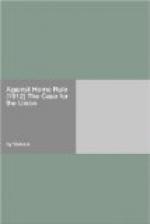Another evil which the Board has had to fight has been the mushroom-like multiplication of small schools. It is hardly necessary to emphasise what must be a manifest disadvantage for any authority which is trying to raise the standard of educational efficiency in a country. This multiplication was largely due to the fact that Protestant Schools were accustomed to receive grants when they could maintain an average attendance of 20 pupils, quite irrespective of how many other schools of the same or a similar denomination there might be in the immediate vicinity, and whether they were really wanted or not. How far these grants were conducive to unnecessary multiplication may be gauged from the fact that, whilst there were 6,500 schools in operation in 1871, when the population of Ireland was five and a half millions, there were 8,692 in 1901, or 2,000 more, when the population was a million less. This vast and unprofitable growth in the numbers of educational establishments could be stayed only by drastic regulation. Where neighbouring mixed Catholic or Protestant schools cannot show an average attendance of 25, they are now obliged to amalgamate, and the same result has to follow if neighbouring boys’ and girls’ schools fall below an average attendance of 30. These regulations have had the desired effect, and no less than 300 superfluous schools have been absorbed in this manner during the last five years.
Before leaving the details of the National Schools, some mention should be made of the conspicuous improvement in the curriculum which has taken place in the first decade of the new century. Formerly, it was hidebound, bloodless, unintelligent, and useless. Now, it does what it can to cater for the practical side of the pupil’s future life, and is designed with the object of helping him to think out problems for himself and of equipping him with any knowledge of the historic past which may serve him, not as a collection of antiquities, but as example and precept. During the last twelve years an astonishing advance has been made. In 1899, Hand and Eye training (including Kindergarten) was taught in 448 schools, in 1910 it was taught in 6,010. In 1899, Elementary Science was taught in 14 schools only, in 1910 it was taught in 2,400. In the former year Cookery was taught in 925 schools, in the latter year in 2,665. In 1899, Laundry Work was taught in 11 schools, in 1910 in 691. If this is not progression—and progression under the Legislative Union—to what can the predicate be more truthfully applied? Statistics are apt to be barren and uninforming and can be adapted, with almost equal plausibility, to support the arguments of either side; but these figures are eloquent and speak for themselves. They embody a large and vital portion of the history of Irish Primary Education, and are a proof of the interest which is being taken in it and of the activity of the architects behind the scenes. Long may this spirit of progress flourish and enlighten the generations that are yet to come!




